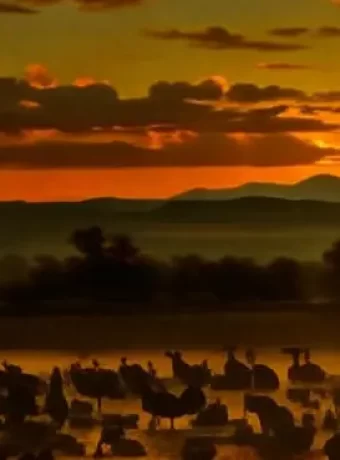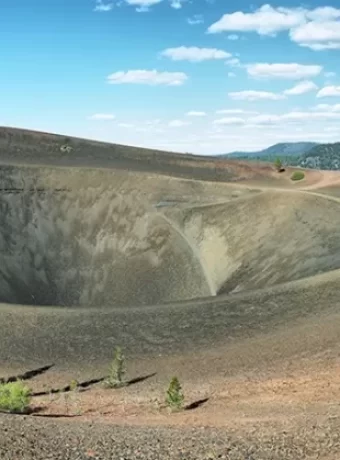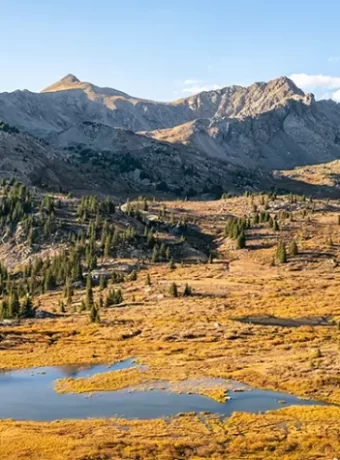Embarking on a journey through the Hiking Lost Creek Wilderness in Colorado isn’t just about lacing up your boots and hitting the trail. This journey is all about diving headfirst into an adventure where each step pulls you deeper into the raw beauty of nature. This 120,000-acre wilderness area near Denver offers solitude rarely found elsewhere. With Harmonic Arch and rare granite formations as its crown jewels, this hike promises more than just a workout; it offers an escape into tranquility.
The trails beckon with challenges like creek crossings and elevation gains but reward hikers with vistas of rolling hills that stretch into eternity. Here’s why putting this destination at the top of your list is a decision you won’t regret.
Table Of Contents:
- Overview of Lost Creek Wilderness Hiking
- Lost Park Reservoir
- Essential Information for Hikers
- Navigating Through Lost Creek Trails
- Capturing Your Adventure: Camera Gear Recommendations
- Survival Gear for Hiking in Lost Creek Wilderness
- FAQs in Relation to Hiking Lost Creek Wilderness Colorado
- Conclusion of Hiking Lost Creek Wilderness
- An Alaskan Wilderness Adventure Awaits
Overview of Hiking Lost Creek Wilderness
If you’re looking for a true wilderness experience, the Lost Creek Wilderness area in Colorado is the place to go.
This 120,000 acre wilderness area is just 60 miles from Denver and 70 miles from Colorado Springs.
Despite its proximity to these major cities, Lost Creek Wilderness is one of the least visited wilderness areas in Colorado, making it perfect for those seeking solitude.
The area is known for its unique granite rock formations, towering domes, and rare granite arches, including Harmonic Arch, one of Colorado’s largest arches.
Lost Creek Wilderness is also home to the Lost Creek Wilderness Loop, a popular multi-day backpacking route that takes hikers through the heart of the wilderness.
Understanding the Lost Creek Wilderness Loop
Trekking the Lost Creek Wilderness Loop, you’ll cover 28.3 miles of terrain that takes you through lush forests and open meadows, all while being surrounded by jaw-dropping rock formations.
The loop is typically completed in 3-4 days, with plenty of options for camping along the way.
The route requires a river crossing that can be tricky depending on water levels and trail conditions, so it’s important to be prepared.
The section of trail between Bison Peak and McCurdy Mountain has little shade and no water sources, so it’s a good idea to fill up before hiking this stretch. I have hiked in from Ute Creek Trailhead along the Tarryall River. Trail twice off the river bottom has a good steep grade to the trail junction for McCurdy Mountain and Buffalo Peak. Beautiful. Buffalo Peak is the highest point in Lost Creek Wilderness.
Exploring Harmonic Arch – One of Colorado’s Largest Arches
One of the highlights of hiking in Lost Creek Wilderness is seeing Harmonic Arch, one of Colorado’s largest granite arch.
The arch is located off the Goose Creek Trail and requires a bit of off-trail hiking to reach, but the effort is well worth it. Spend a night down on the flats along Goose Creek. The fly fishing isn’t bad, with stunning starry skies.

Backpack & hiking the many Rocky Mountain Wilderness Areas I have explored and hope to still. Be prepared its important. Don’t get me wrong, I still forget items. I like a Prestige one weight to 11′ three weight for backpacking. High quality outdoor apparel in fun Graphic Hoodies. Right down to my sun protective fingerless gloves.
Stretching over 100 feet, this arch is truly a breathtaking spectacle. Hike up to Harmonic Arch was an awe inspiring experience. Out on the granite dome before approaching the arch. I hiked to the arch on first weekend in May after a morning snow blanketed the forest.
Keep in mind that the area around Harmonic Arch is fragile, so it’s important to practice Leave No Trace principles and avoid climbing on the arch itself.
Goose Creek Trail Lost Park Reservoir
Lost Park Reservoir is the remains of a dam town as one could say. History, beauty, with camping on the upper reaches of Goose Creek before entering Refrigerator Canyon. Or heading to Wigwam Trailhead or Lost Park Campground. Lost Park Reservoir can be a day hike, which I have done several times.
Wigwam Trail Lost Creek Wilderness
Wigwam Trail is a moderate trail up to Goose Creek Trail junction. Or hike through to Lost Park Campground Trailhead. Make a weekend of it, go with a group. One hike in from Wigwam Trailhead and the other Lost Park, meet and camp at Goose Creek Trail Junction. Exchange keys in the morning a must and part ways. Maybe make a weekend of it.
Lizard Rock Trail Lost Creek Wilderness
Trailhead starts just off of Tarryall Rd at Spruce Grove Campground. Hiked up to Hankins Pass. Incredibly cool rock formations. Encountered a lynx on this journey. That encounter more that made and already perfect day.
Essential Information for Hikers
Before embarking on a hiking or backpacking trip in Lost Creek Wilderness, there are a few essential things to know. Be prepared for all weather conditions. I gets very cool after dark.
Lost Creek Wilderness Permit System
Wilderness permits are required for hiking and backpacking in Lost Creek Wilderness, but they are self-issued at the trailheads and are free of charge.
Simply fill out a permit at the trailhead before starting your hike.
It’s important to carry your permit with you at all times while in the wilderness.
Camping Rules in Lost Creek Wilderness
Camping is allowed in Lost Creek Wilderness, but there are some important rules to follow.
Campsites must be at least 100 feet from any water source and 0.25 miles from trailheads and developed areas.
Campfires are allowed in existing fire rings, but it’s always a good idea to check for any fire restrictions before your trip.
Remember to practice Leave No Trace principles and pack out all trash, including toilet paper.
Weather Averages for Safe Planning
The weather in Lost Creek Wilderness can be unpredictable, so it’s important to be prepared for a range of conditions.
In the summer months, temperatures can reach into the 80s during the day but drop into the 40s at night.
Afternoon thunderstorms are common in the summer, so it’s a good idea to start your hikes early and be prepared for rain.
In the winter, temperatures can drop well below freezing and snow is common at higher elevations.
It’s important to check the weather forecast before your trip and pack accordingly.
Navigating Through Lost Creek Trails
Lost Creek Wilderness has over 130 miles of trails, ranging from easy day hikes to strenuous multi-day backpacking routes.
Creek Crossings: Challenges and Tips
One of the challenges of hiking in Lost Creek Wilderness is navigating creek crossings.
Many of the trails in the area require hikers to cross creeks and streams, which can be tricky depending on water levels and trail conditions.
It’s important to assess the situation carefully before attempting a crossing and to use caution when navigating slippery rocks or fast-moving water.
Trekking poles can be helpful for maintaining balance, and it’s a good idea to bring a pair of water shoes or sandals for crossing creeks.
Recommended Routes in Lost Creek Wilderness
With so many trails to choose from, it can be overwhelming to plan a route in Lost Creek Wilderness.
One popular option is the Lost Creek Wilderness Loop, a 28.3-mile backpacking route that takes hikers through the heart of the wilderness.
For a shorter day hike, the McCurdy Park Trail is a great option, offering stunning views of the surrounding peaks and rock formations.
The Refrigerator Gulch Trail is another popular choice, taking hikers through a narrow canyon and past unique rock formations.
Wigwam Trail from trailhead to Goose Creek Trail Junction. There is a large beaver pond with a 8 tall beaver dam and it’s damn cool. Lots of good camping.
Exploring Trails in Lost Creek Wilderness
No matter which trail you choose, exploring Lost Creek Wilderness is an unforgettable experience.
The area’s unique geology and stunning scenery make it a hiker’s paradise, with endless opportunities for adventure and solitude.
Whether you’re a seasoned backpacker or a first-time hiker, Lost Creek Wilderness has something to offer.
So lace up your boots, grab your pack, and get ready to explore one of Colorado’s most beautiful and rugged wilderness areas.
Lost Creek Wilderness Tip:
Ready for an adventure close to Denver and Colorado Springs? Lost Creek Wilderness offers unique granite formations, rare arches, and secluded trails. With over 130 miles of paths like the Lost Creek Wilderness Loop and Harmonic Arch viewing, there’s plenty for every hiker. Remember: permits are free but required, pack out trash, check weather forecasts, and prep for creek crossings.
Capturing Your Adventure: Camera Gear Recommendations
You’ve planned your epic hike through the Lost Creek Wilderness. Now it’s time to make sure you capture all the breathtaking moments along the way.
Now, let’s chat about those majestic granite peaks, unique rock shapes that you don’t see just anywhere, and the sprawling beauty of Colorado that will have your Instagram followers hitting ‘like’ faster than ever before.
But to snap those share-worthy shots, you need the right camera gear. Here’s my list of must-haves:
Choosing a Durable Backpack for Your Gear
First up, a backpack that can withstand the rigors of the trail. My pick? The Osprey Atmos/Aura AG 65 Pack.
This gem is all about comfort, even when it’s packed to the brim with your stuff. The Anti-Gravity suspension system makes it feel like you’re carrying less weight, and the ventilated back panel keeps you cool on those hot summer hikes.
And let’s not forget, with a generous 65-liter capacity, there’s more than enough space to pack your camera gear, stash some snacks for the road, and toss in a few extra layers just in case.
The Importance of a Reliable Tripod
Next on the list, a sturdy tripod. Trust me, when you’re shooting in low light or trying to capture that perfect landscape shot, you’ll be glad you have one.
I recommend the Ground-Level Tripod. It’s lightweight, compact, and easy to set up – perfect for those spontaneous photo ops on the trail.
The low angle design also lets you get creative with your compositions and capture unique perspectives of the Lost Creek Wilderness.
Selecting the Right Camera for Outdoor Photography
Finally, the star of the show – your camera. If you’re snapping shots outdoors, what you really need is gear that’s tough enough to take on the weather and still snap breathtaking photos.
My top pick? The Nikon D780 Body. This full-frame DSLR is a beast in low light situations, thanks to its powerful ISO range and fast autofocus system.
It’s also weather-sealed, so you don’t have to worry about a little rain or dust ruining your shot. Now, thanks to the 4K video feature, you have the power to capture every stunning detail of the wilderness like never before.
So there you have it – my top picks for camera gear to bring on your Lost Creek Wilderness adventure. With the right equipment, you’ll be able to document every epic moment and share the beauty of this incredible place with the world.
Survival Gear for Hiking in Lost Creek Wilderness
Now, let’s dive into the gear that’ll ensure you’re both safe and snug during your adventure in Lost Creek Wilderness.
Sure, the views are incredible, but you know what’s not incredible? Blisters, dehydration, and cold camp meals. Believe me, picking the right survival gear pays off big time.
Choosing the Right Hiking Boots
First things first, let’s talk about your feet. They’re going to be carrying you over miles of rugged terrain, so you need to treat them right.
My go-to hiking boots? Merrell Moab . These bad boys are not waterproof, are breathable, and provide killer support on even the gnarliest of trails. I just don’t like high tops personally and have hiked several wilderness areas and trail in Sandals. My favorite was the original Merrell Choprock, they were the bomb. Best I have ever seen. I put on some serious miles.
The outsole gives you serious traction on slick rocks and loose dirt, while the cushioned midsole keeps your feet happy mile after mile. Trust me, your toes will thank you.
The Importance of a Reliable Water Purifier Bottle
Next up, hydration. When you’re hiking in the backcountry, you can’t always count on finding clean water sources. That’s where a reliable water purifier bottle comes in clutch.
I use a couple of different Water Purifiers, a Journey Bottle. A portable water treatment plant in your backpack, is a MSR at the moment. On extended trips I use a Sawyer water filter and smart water bottles.
Just fill it up from any freshwater source, press the button, and voila – safe, clean drinking water in just 8 seconds. No more lugging around heavy water bottles or risking a case of giardia.
Essential Cooking Stove for Camping
Last but not least, let’s talk about camp cooking. After a long day on the trail, there’s nothing better than a hot meal to refuel and recharge.
My pick for the best camping stove? Jet Boil for Coffee and Cooking Stove. I know, it’s a mouthful, but trust me – this little stove packs a punch.
Weighing in at just 25 grams, it’s insanely lightweight and compact. But don’t let its size fool you – it boils water in just 2 minutes and 58 seconds, perfect for whipping up a quick backcountry feast.
So there you have it – my top picks for survival gear to bring on your Lost Creek Wilderness hike. With the right boots, water purifier, and cooking stove, you’ll be ready to tackle anything the trail throws your way.
Ready to hike Lost Creek Wilderness? Pack smart with an Osprey backpack, a TP-243 tripod for epic shots, the rugged Nikon D780, and don’t forget survival essentials like Salomon boots, a GRAYL water purifier bottle, and the BRS-3000T stove. Stay safe and snap away.
FAQs in Relation to Hiking Lost Creek Wilderness Colorado
Are bear canisters required in the Lost Creek Wilderness?
No, bear canisters aren’t mandatory. However, smart food storage practices are highly recommended to ensure both your safety and that of the bears.
How do I get to Lost Creek Wilderness?
To reach Lost Creek Wilderness, drive from Denver via US-285 South. Turn right onto County Road 56 at Bailey and follow the signs to the trailheads.
What is the elevation of the Lost Creek Wilderness?
The elevation in Lost Creek Wilderness ranges from about 8,000 feet up to the tree line near 12,400 feet. Be prepared for some altitude.
Where is the Lost Creek backpacking site?
There are multiple backpacking sites along trails such as Goose Creek and Refrigerator Gulch in Lost Creek Wilderness. For specific locations, it’s best to check maps as these sites are not marked. I use National Geographic Tarryall Mts. / Kenosha Pass Map. And a GPS app. To navigate all my experiences in Hiking Lost Creek Wilderness.
Conclusion of Hiking Lost Creek Wilderness
In wrapping up our trek through words on hiking Lost Creek Wilderness Colorado, remember that these paths offer not only physical journeys but also voyages within ourselves. Whether standing beneath Harmonic Arch or navigating creeks that crisscross ancient landscapes, we’re reminded of nature’s enduring allure.
This vast expanse serves as both canvas and muse—inspiring us to explore further while respecting its sanctity. So lace up those boots one more time because exploring Lost Creek isn’t merely about marking off another trail; it’s embracing an ongoing adventure towards discovery—and perhaps finding parts of ourselves along the way.
An Alaskan Wilderness Adventure Awaits
Or a plane to Iceland for Premier Fly Fishing Experience. Trophy brook trout you say, Fortress Lake is about as remote as you can get. Learn more about Fly Fishing Adventures, Click Here.






